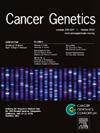2. Diagnostic next generation sequencing to detect MYD88 L265P in lymphoplasmacytic lymphoma compared to ddPCR
IF 1.4
4区 医学
Q4 GENETICS & HEREDITY
引用次数: 0
Abstract
Lymphoplasmacytic lymphoma (LPL) is a B-cell lymphoproliferative disorder characterized by bone marrow infiltration of lymphoplasmacytic cells. Studies have identified MYD88 L265P mutation as a diagnostic marker to distinguish LPL from other small B-cell lymphomas (e.g. marginal zone lymphoma, chronic lymphocytic leukemia). However, detection rates for this mutation have varied depending on the analytic methodology, with data suggesting that routine Next Generation Sequencing (NGS) does not demonstrate the required sensitivity to reliably detect MYD88 L265P. NGS has become a work-horse of the modern genetic laboratory by basketing multiple single-gene assays into one multiplexed assay. In several routine cases, visual observation using IGV demonstrated MYD88 L265P variants in cases of suspected LPL with low tumor content. To study this, we performed droplet digital PCR (ddPCR) and our routine NGS for MYD88 L265P in a cohort of 35 cases of lymphoid neoplasms (25 LPL, 6 CLL, 4 negative bone marrow cases). Our standard NGS method achieved an average depth of ∼535 reads across this region. We utilized manual review and BAMtools to assess MYD88 L265P in NGS cases. Limit of detection for ddPCR was determined to be 0.3% variant allele frequency (VAF) with 10ng DNA input. MYD88 L265P VAF detection by NGS and ddPCR was comparable down to 0.5% VAF (R2=0.968). Setting an appropriate threshold for detection based on ddPCR results resulted in zero NGS false positives. This study demonstrates that NGS can be a sensitive and reliable method for detection of MYD88 L265P with adequate coverage and specific assessment parameters.
2.诊断性新一代测序检测淋巴浆细胞性淋巴瘤中的 MYD88 L265P 与 ddPCR 的比较
淋巴浆细胞性淋巴瘤(LPL)是一种以淋巴浆细胞骨髓浸润为特征的 B 细胞淋巴增生性疾病。研究发现,MYD88 L265P 突变是区分 LPL 与其他小 B 细胞淋巴瘤(如边缘区淋巴瘤、慢性淋巴细胞白血病)的诊断标志物。然而,这种突变的检出率因分析方法的不同而不同,有数据表明,常规的下一代测序(NGS)并不能显示出可靠检测 MYD88 L265P 所需的灵敏度。NGS 将多种单基因检测方法整合为一种多重检测方法,已成为现代基因实验室的工作工具。在几个常规病例中,使用 IGV 的肉眼观察显示,在肿瘤含量较低的疑似 LPL 病例中存在 MYD88 L265P 变异。为了研究这一点,我们对 35 例淋巴肿瘤病例(25 例 LPL、6 例 CLL、4 例骨髓阴性病例)进行了液滴数字 PCR(ddPCR)和常规 NGS 检测 MYD88 L265P。我们的标准 NGS 方法在该区域的平均深度达到了 535 个读数。我们利用人工审核和 BAMtools 评估了 NGS 病例中的 MYD88 L265P。在输入 10ng DNA 时,ddPCR 的检测限被确定为 0.3% 的变异等位基因频率 (VAF)。NGS 和 ddPCR 的 MYD88 L265P VAF 检测结果相当,最低可达 0.5% VAF(R2=0.968)。根据 ddPCR 结果设置适当的检测阈值,NGS 的假阳性结果为零。本研究表明,NGS 是检测 MYD88 L265P 的一种灵敏可靠的方法,具有足够的覆盖率和特定的评估参数。
本文章由计算机程序翻译,如有差异,请以英文原文为准。
求助全文
约1分钟内获得全文
求助全文
来源期刊

Cancer Genetics
ONCOLOGY-GENETICS & HEREDITY
CiteScore
3.20
自引率
5.30%
发文量
167
审稿时长
27 days
期刊介绍:
The aim of Cancer Genetics is to publish high quality scientific papers on the cellular, genetic and molecular aspects of cancer, including cancer predisposition and clinical diagnostic applications. Specific areas of interest include descriptions of new chromosomal, molecular or epigenetic alterations in benign and malignant diseases; novel laboratory approaches for identification and characterization of chromosomal rearrangements or genomic alterations in cancer cells; correlation of genetic changes with pathology and clinical presentation; and the molecular genetics of cancer predisposition. To reach a basic science and clinical multidisciplinary audience, we welcome original full-length articles, reviews, meeting summaries, brief reports, and letters to the editor.
 求助内容:
求助内容: 应助结果提醒方式:
应助结果提醒方式:


